Applying Theories, Principles, and Models in Education & Training
VerifiedAdded on 2024/06/07
|19
|3671
|327
Report
AI Summary
This report provides an analysis of various theories, principles, and models relevant to education and training. It explores behavioral, cognitivist, and humanist learning theories, detailing their application in teaching, learning, and assessment. The report also analyzes models of learning preference and their impact on inclusive teaching. Furthermore, it examines communication theories like the process school, hypodermic theory, and Aristotle's model, explaining their role in effective learning. The document delves into assessment models, including diagnostic, formative, and summative assessments, and their application in evaluating learning outcomes. Additionally, it analyzes curriculum development theories and models, as well as theories of reflection and evaluation for reviewing teaching practices. The report emphasizes the importance of effective communication and tailored learning approaches for enhanced educational outcomes.
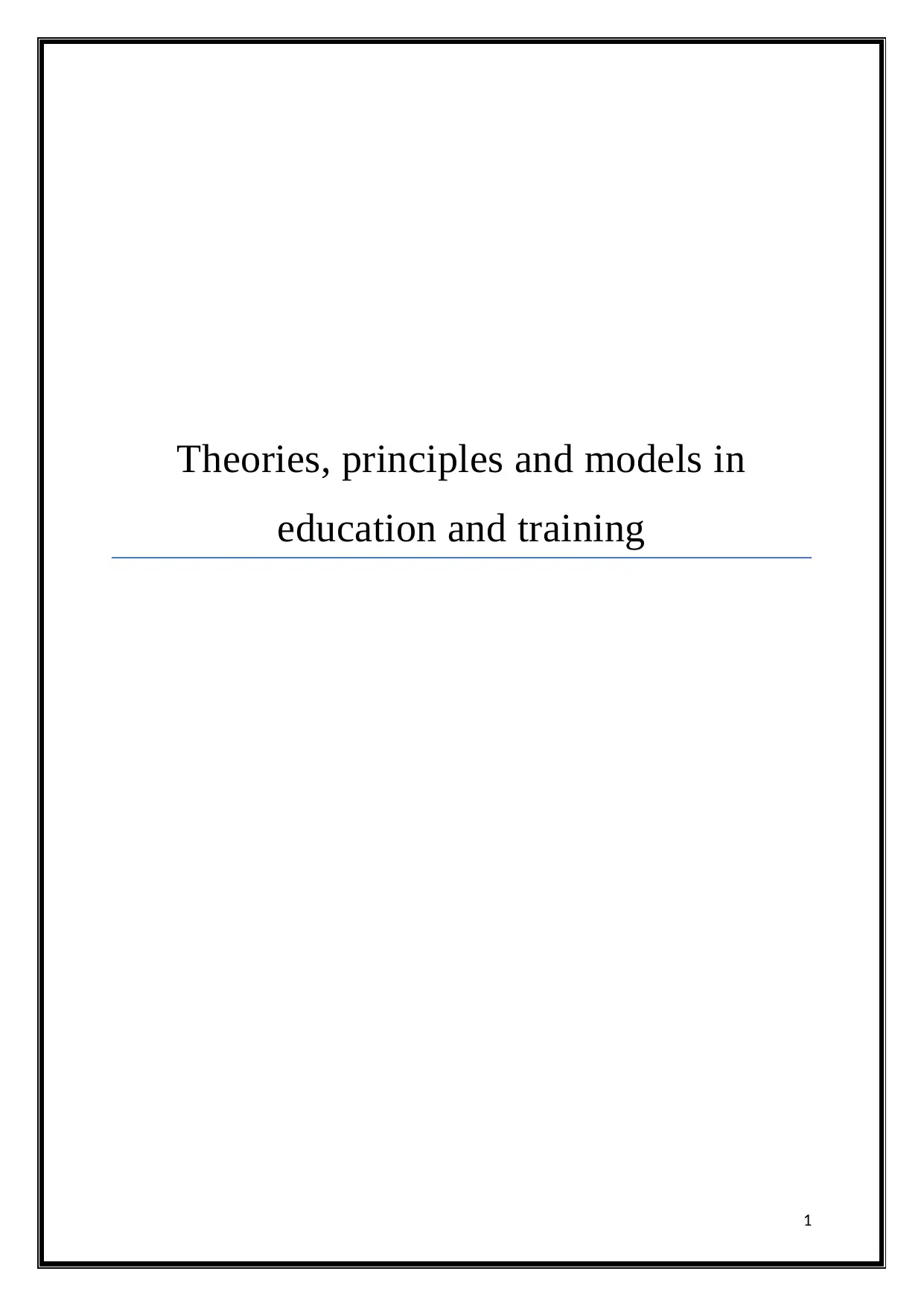
Theories, principles and models in
education and training
1
education and training
1
Paraphrase This Document
Need a fresh take? Get an instant paraphrase of this document with our AI Paraphraser
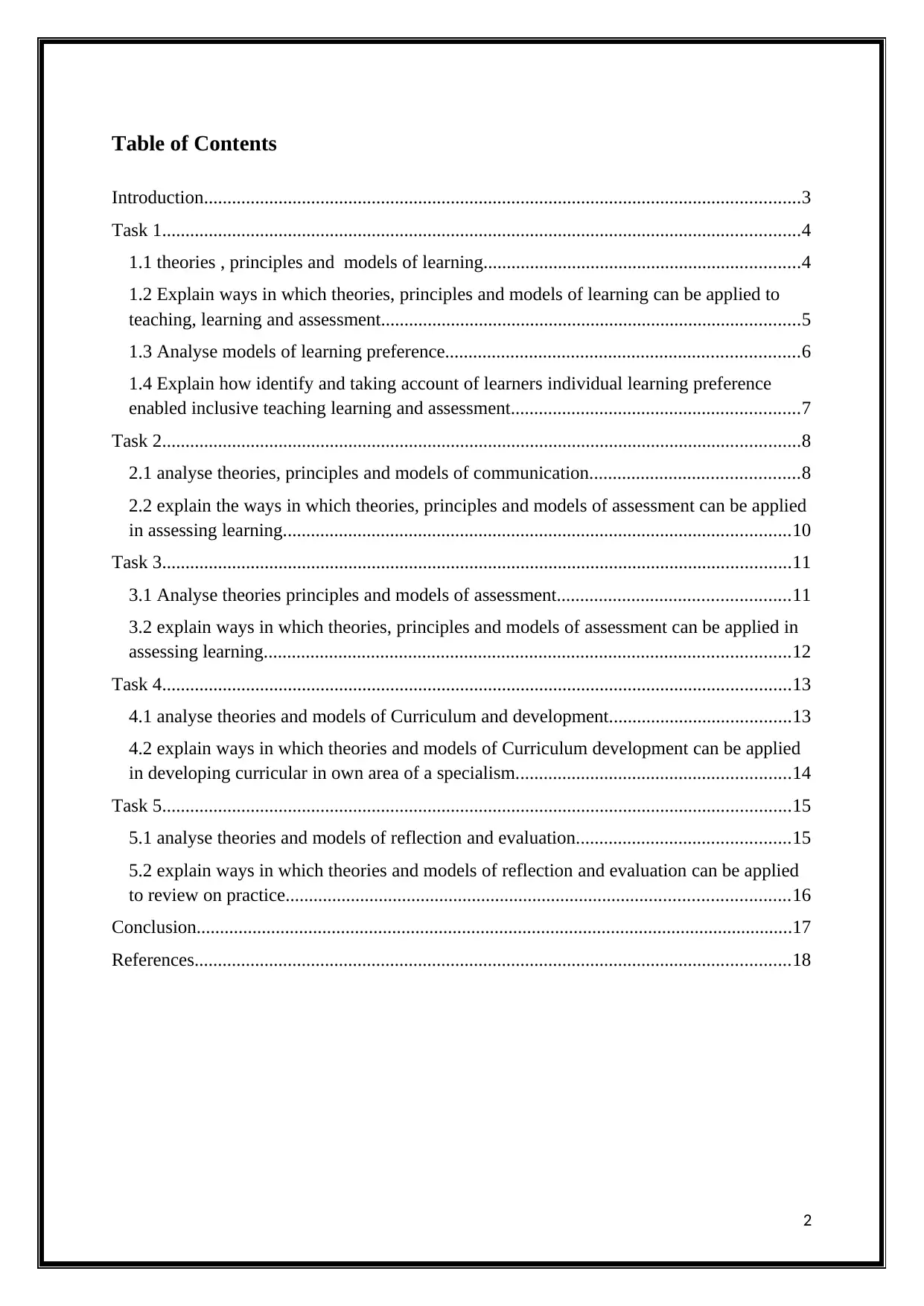
Table of Contents
Introduction................................................................................................................................3
Task 1.........................................................................................................................................4
1.1 theories , principles and models of learning....................................................................4
1.2 Explain ways in which theories, principles and models of learning can be applied to
teaching, learning and assessment..........................................................................................5
1.3 Analyse models of learning preference............................................................................6
1.4 Explain how identify and taking account of learners individual learning preference
enabled inclusive teaching learning and assessment..............................................................7
Task 2.........................................................................................................................................8
2.1 analyse theories, principles and models of communication.............................................8
2.2 explain the ways in which theories, principles and models of assessment can be applied
in assessing learning.............................................................................................................10
Task 3.......................................................................................................................................11
3.1 Analyse theories principles and models of assessment..................................................11
3.2 explain ways in which theories, principles and models of assessment can be applied in
assessing learning.................................................................................................................12
Task 4.......................................................................................................................................13
4.1 analyse theories and models of Curriculum and development.......................................13
4.2 explain ways in which theories and models of Curriculum development can be applied
in developing curricular in own area of a specialism...........................................................14
Task 5.......................................................................................................................................15
5.1 analyse theories and models of reflection and evaluation..............................................15
5.2 explain ways in which theories and models of reflection and evaluation can be applied
to review on practice............................................................................................................16
Conclusion................................................................................................................................17
References................................................................................................................................18
2
Introduction................................................................................................................................3
Task 1.........................................................................................................................................4
1.1 theories , principles and models of learning....................................................................4
1.2 Explain ways in which theories, principles and models of learning can be applied to
teaching, learning and assessment..........................................................................................5
1.3 Analyse models of learning preference............................................................................6
1.4 Explain how identify and taking account of learners individual learning preference
enabled inclusive teaching learning and assessment..............................................................7
Task 2.........................................................................................................................................8
2.1 analyse theories, principles and models of communication.............................................8
2.2 explain the ways in which theories, principles and models of assessment can be applied
in assessing learning.............................................................................................................10
Task 3.......................................................................................................................................11
3.1 Analyse theories principles and models of assessment..................................................11
3.2 explain ways in which theories, principles and models of assessment can be applied in
assessing learning.................................................................................................................12
Task 4.......................................................................................................................................13
4.1 analyse theories and models of Curriculum and development.......................................13
4.2 explain ways in which theories and models of Curriculum development can be applied
in developing curricular in own area of a specialism...........................................................14
Task 5.......................................................................................................................................15
5.1 analyse theories and models of reflection and evaluation..............................................15
5.2 explain ways in which theories and models of reflection and evaluation can be applied
to review on practice............................................................................................................16
Conclusion................................................................................................................................17
References................................................................................................................................18
2
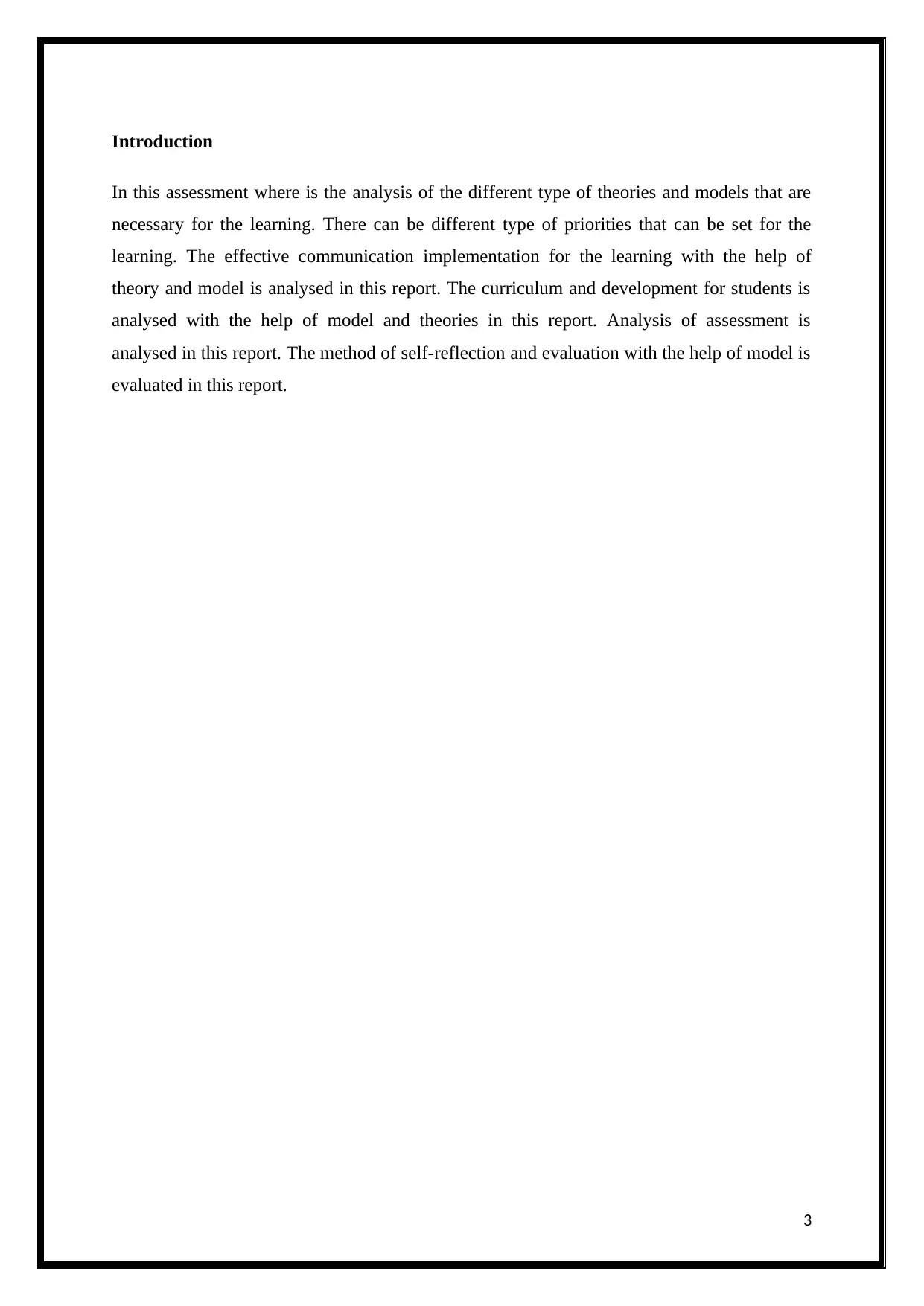
Introduction
In this assessment where is the analysis of the different type of theories and models that are
necessary for the learning. There can be different type of priorities that can be set for the
learning. The effective communication implementation for the learning with the help of
theory and model is analysed in this report. The curriculum and development for students is
analysed with the help of model and theories in this report. Analysis of assessment is
analysed in this report. The method of self-reflection and evaluation with the help of model is
evaluated in this report.
3
In this assessment where is the analysis of the different type of theories and models that are
necessary for the learning. There can be different type of priorities that can be set for the
learning. The effective communication implementation for the learning with the help of
theory and model is analysed in this report. The curriculum and development for students is
analysed with the help of model and theories in this report. Analysis of assessment is
analysed in this report. The method of self-reflection and evaluation with the help of model is
evaluated in this report.
3
⊘ This is a preview!⊘
Do you want full access?
Subscribe today to unlock all pages.

Trusted by 1+ million students worldwide
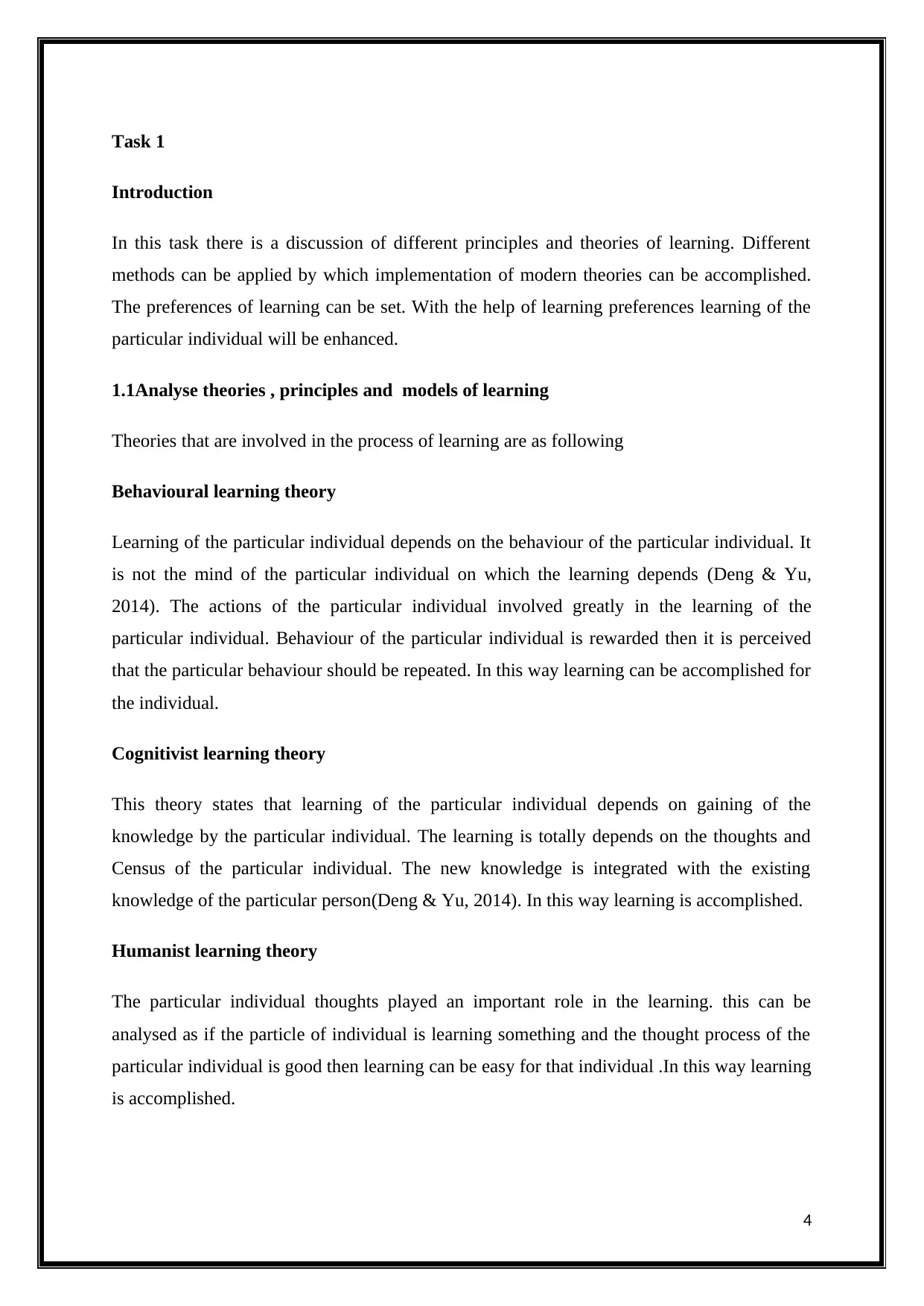
Task 1
Introduction
In this task there is a discussion of different principles and theories of learning. Different
methods can be applied by which implementation of modern theories can be accomplished.
The preferences of learning can be set. With the help of learning preferences learning of the
particular individual will be enhanced.
1.1Analyse theories , principles and models of learning
Theories that are involved in the process of learning are as following
Behavioural learning theory
Learning of the particular individual depends on the behaviour of the particular individual. It
is not the mind of the particular individual on which the learning depends (Deng & Yu,
2014). The actions of the particular individual involved greatly in the learning of the
particular individual. Behaviour of the particular individual is rewarded then it is perceived
that the particular behaviour should be repeated. In this way learning can be accomplished for
the individual.
Cognitivist learning theory
This theory states that learning of the particular individual depends on gaining of the
knowledge by the particular individual. The learning is totally depends on the thoughts and
Census of the particular individual. The new knowledge is integrated with the existing
knowledge of the particular person(Deng & Yu, 2014). In this way learning is accomplished.
Humanist learning theory
The particular individual thoughts played an important role in the learning. this can be
analysed as if the particle of individual is learning something and the thought process of the
particular individual is good then learning can be easy for that individual .In this way learning
is accomplished.
4
Introduction
In this task there is a discussion of different principles and theories of learning. Different
methods can be applied by which implementation of modern theories can be accomplished.
The preferences of learning can be set. With the help of learning preferences learning of the
particular individual will be enhanced.
1.1Analyse theories , principles and models of learning
Theories that are involved in the process of learning are as following
Behavioural learning theory
Learning of the particular individual depends on the behaviour of the particular individual. It
is not the mind of the particular individual on which the learning depends (Deng & Yu,
2014). The actions of the particular individual involved greatly in the learning of the
particular individual. Behaviour of the particular individual is rewarded then it is perceived
that the particular behaviour should be repeated. In this way learning can be accomplished for
the individual.
Cognitivist learning theory
This theory states that learning of the particular individual depends on gaining of the
knowledge by the particular individual. The learning is totally depends on the thoughts and
Census of the particular individual. The new knowledge is integrated with the existing
knowledge of the particular person(Deng & Yu, 2014). In this way learning is accomplished.
Humanist learning theory
The particular individual thoughts played an important role in the learning. this can be
analysed as if the particle of individual is learning something and the thought process of the
particular individual is good then learning can be easy for that individual .In this way learning
is accomplished.
4
Paraphrase This Document
Need a fresh take? Get an instant paraphrase of this document with our AI Paraphraser
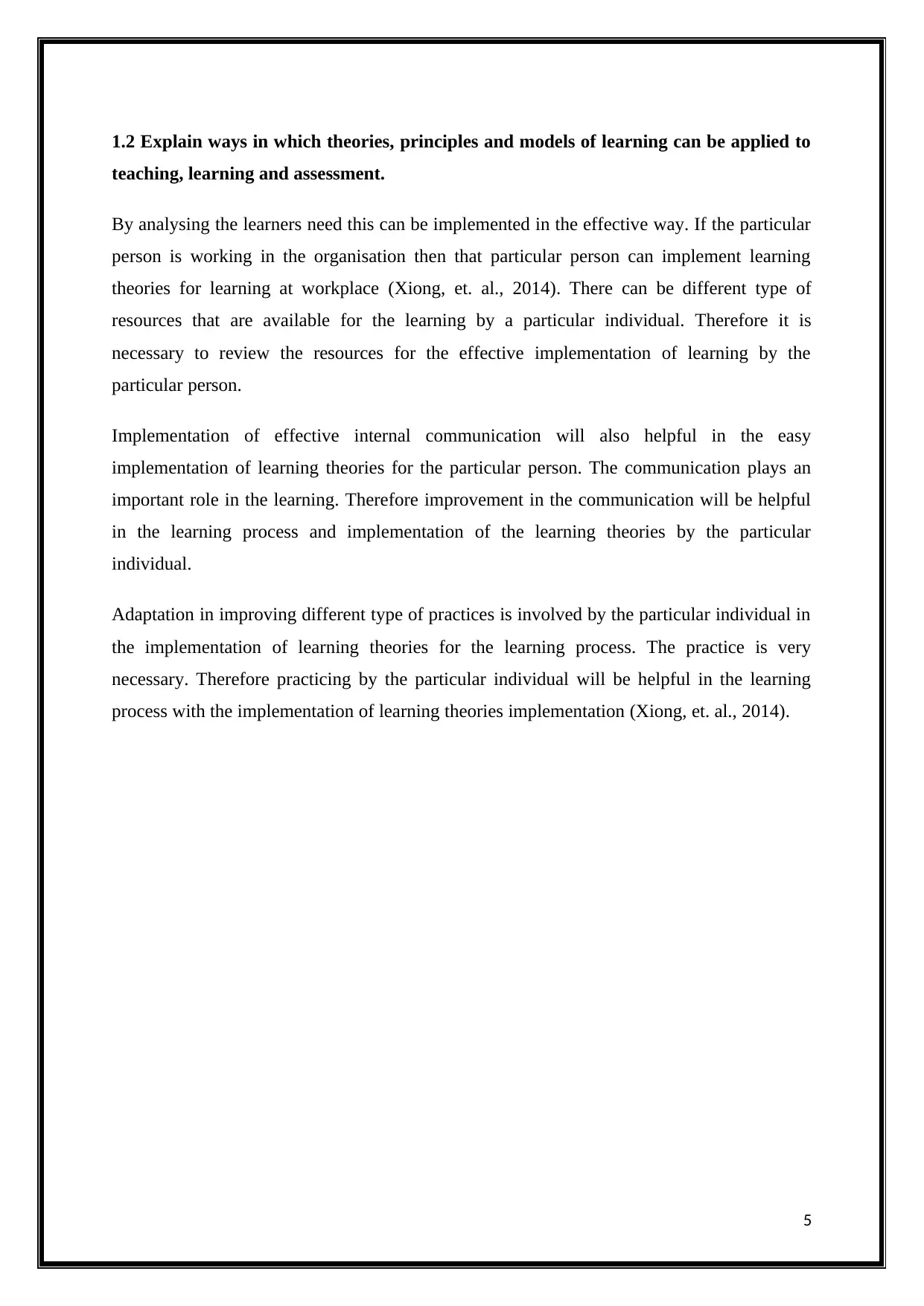
1.2 Explain ways in which theories, principles and models of learning can be applied to
teaching, learning and assessment.
By analysing the learners need this can be implemented in the effective way. If the particular
person is working in the organisation then that particular person can implement learning
theories for learning at workplace (Xiong, et. al., 2014). There can be different type of
resources that are available for the learning by a particular individual. Therefore it is
necessary to review the resources for the effective implementation of learning by the
particular person.
Implementation of effective internal communication will also helpful in the easy
implementation of learning theories for the particular person. The communication plays an
important role in the learning. Therefore improvement in the communication will be helpful
in the learning process and implementation of the learning theories by the particular
individual.
Adaptation in improving different type of practices is involved by the particular individual in
the implementation of learning theories for the learning process. The practice is very
necessary. Therefore practicing by the particular individual will be helpful in the learning
process with the implementation of learning theories implementation (Xiong, et. al., 2014).
5
teaching, learning and assessment.
By analysing the learners need this can be implemented in the effective way. If the particular
person is working in the organisation then that particular person can implement learning
theories for learning at workplace (Xiong, et. al., 2014). There can be different type of
resources that are available for the learning by a particular individual. Therefore it is
necessary to review the resources for the effective implementation of learning by the
particular person.
Implementation of effective internal communication will also helpful in the easy
implementation of learning theories for the particular person. The communication plays an
important role in the learning. Therefore improvement in the communication will be helpful
in the learning process and implementation of the learning theories by the particular
individual.
Adaptation in improving different type of practices is involved by the particular individual in
the implementation of learning theories for the learning process. The practice is very
necessary. Therefore practicing by the particular individual will be helpful in the learning
process with the implementation of learning theories implementation (Xiong, et. al., 2014).
5
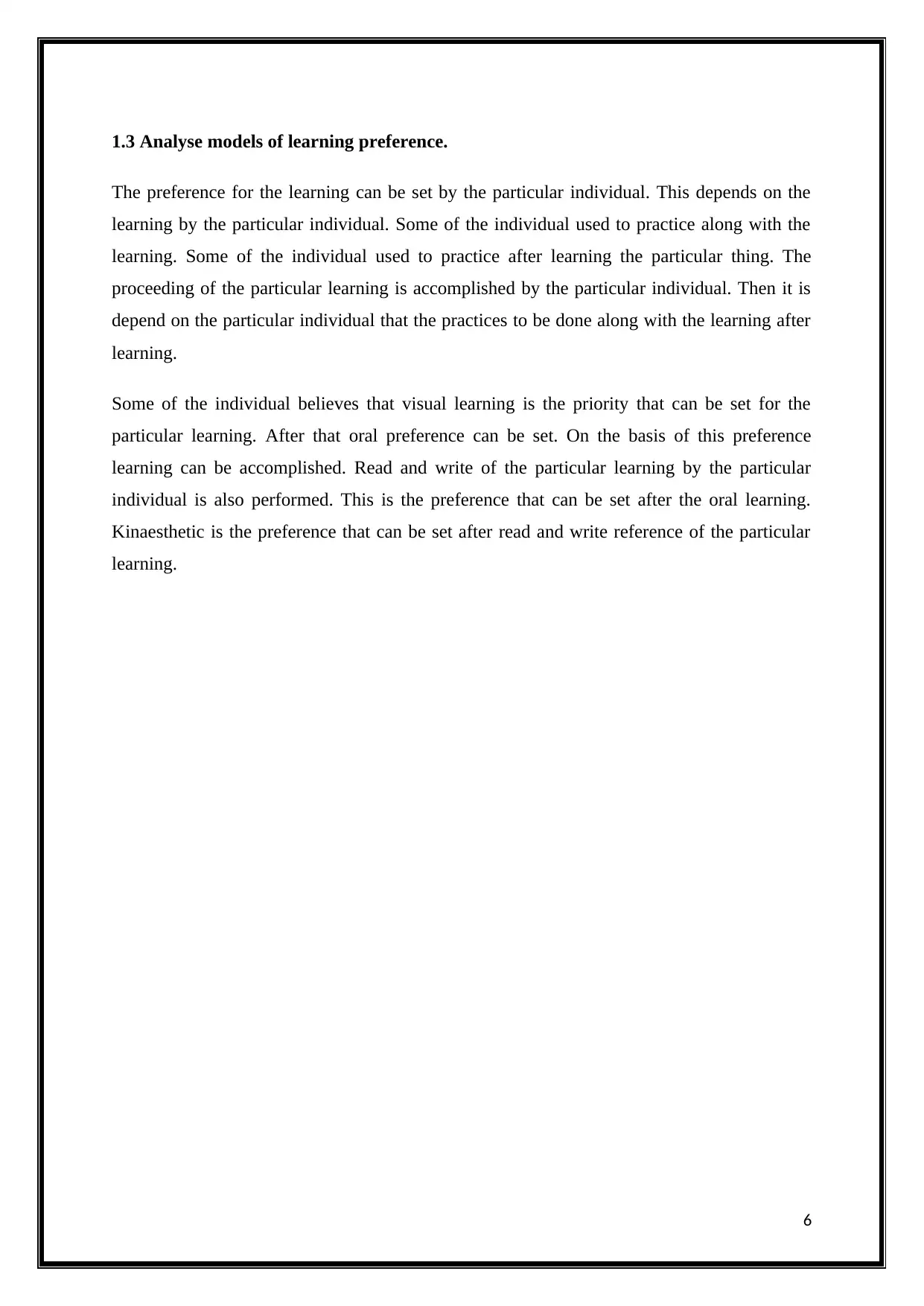
1.3 Analyse models of learning preference.
The preference for the learning can be set by the particular individual. This depends on the
learning by the particular individual. Some of the individual used to practice along with the
learning. Some of the individual used to practice after learning the particular thing. The
proceeding of the particular learning is accomplished by the particular individual. Then it is
depend on the particular individual that the practices to be done along with the learning after
learning.
Some of the individual believes that visual learning is the priority that can be set for the
particular learning. After that oral preference can be set. On the basis of this preference
learning can be accomplished. Read and write of the particular learning by the particular
individual is also performed. This is the preference that can be set after the oral learning.
Kinaesthetic is the preference that can be set after read and write reference of the particular
learning.
6
The preference for the learning can be set by the particular individual. This depends on the
learning by the particular individual. Some of the individual used to practice along with the
learning. Some of the individual used to practice after learning the particular thing. The
proceeding of the particular learning is accomplished by the particular individual. Then it is
depend on the particular individual that the practices to be done along with the learning after
learning.
Some of the individual believes that visual learning is the priority that can be set for the
particular learning. After that oral preference can be set. On the basis of this preference
learning can be accomplished. Read and write of the particular learning by the particular
individual is also performed. This is the preference that can be set after the oral learning.
Kinaesthetic is the preference that can be set after read and write reference of the particular
learning.
6
⊘ This is a preview!⊘
Do you want full access?
Subscribe today to unlock all pages.

Trusted by 1+ million students worldwide
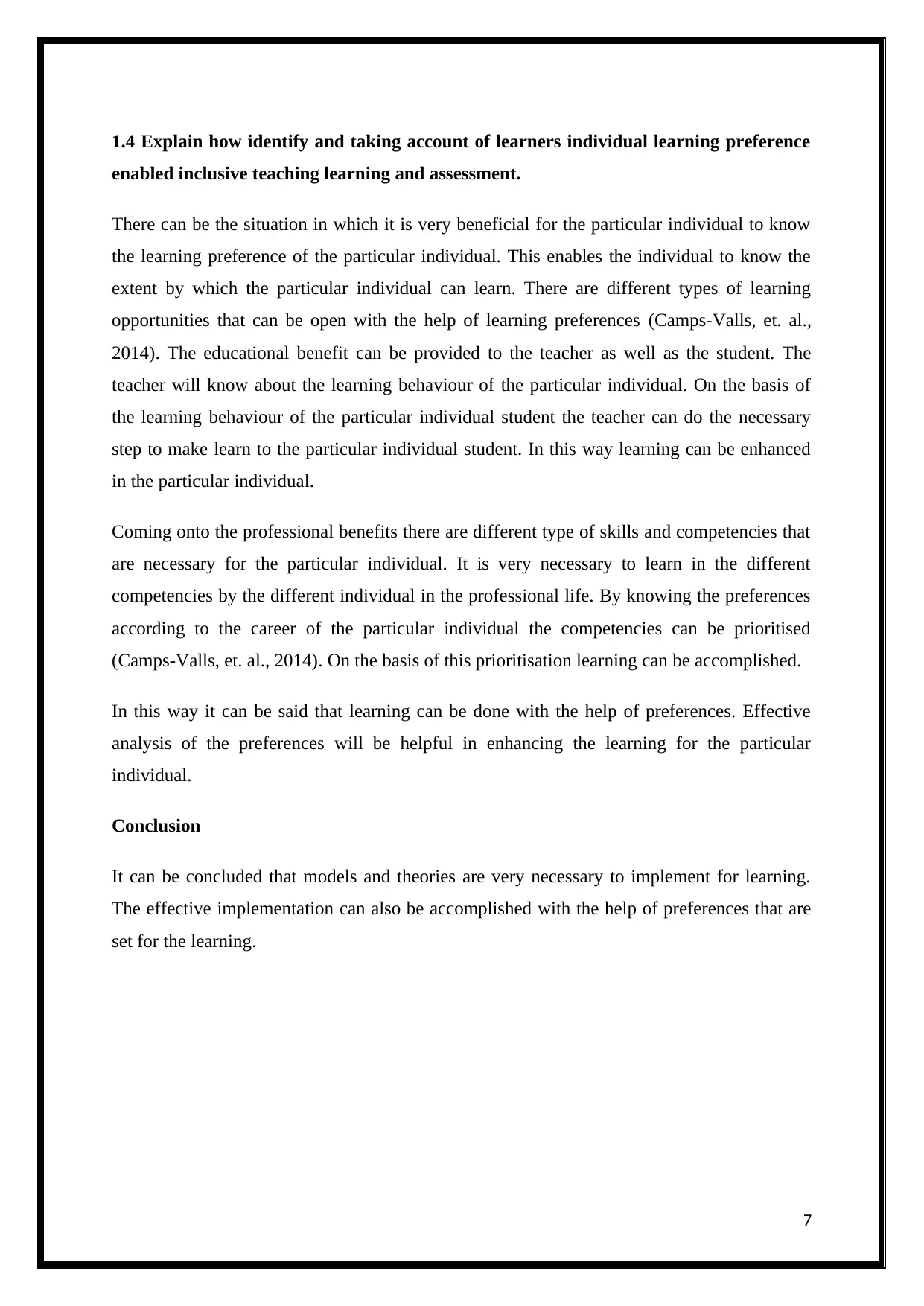
1.4 Explain how identify and taking account of learners individual learning preference
enabled inclusive teaching learning and assessment.
There can be the situation in which it is very beneficial for the particular individual to know
the learning preference of the particular individual. This enables the individual to know the
extent by which the particular individual can learn. There are different types of learning
opportunities that can be open with the help of learning preferences (Camps-Valls, et. al.,
2014). The educational benefit can be provided to the teacher as well as the student. The
teacher will know about the learning behaviour of the particular individual. On the basis of
the learning behaviour of the particular individual student the teacher can do the necessary
step to make learn to the particular individual student. In this way learning can be enhanced
in the particular individual.
Coming onto the professional benefits there are different type of skills and competencies that
are necessary for the particular individual. It is very necessary to learn in the different
competencies by the different individual in the professional life. By knowing the preferences
according to the career of the particular individual the competencies can be prioritised
(Camps-Valls, et. al., 2014). On the basis of this prioritisation learning can be accomplished.
In this way it can be said that learning can be done with the help of preferences. Effective
analysis of the preferences will be helpful in enhancing the learning for the particular
individual.
Conclusion
It can be concluded that models and theories are very necessary to implement for learning.
The effective implementation can also be accomplished with the help of preferences that are
set for the learning.
7
enabled inclusive teaching learning and assessment.
There can be the situation in which it is very beneficial for the particular individual to know
the learning preference of the particular individual. This enables the individual to know the
extent by which the particular individual can learn. There are different types of learning
opportunities that can be open with the help of learning preferences (Camps-Valls, et. al.,
2014). The educational benefit can be provided to the teacher as well as the student. The
teacher will know about the learning behaviour of the particular individual. On the basis of
the learning behaviour of the particular individual student the teacher can do the necessary
step to make learn to the particular individual student. In this way learning can be enhanced
in the particular individual.
Coming onto the professional benefits there are different type of skills and competencies that
are necessary for the particular individual. It is very necessary to learn in the different
competencies by the different individual in the professional life. By knowing the preferences
according to the career of the particular individual the competencies can be prioritised
(Camps-Valls, et. al., 2014). On the basis of this prioritisation learning can be accomplished.
In this way it can be said that learning can be done with the help of preferences. Effective
analysis of the preferences will be helpful in enhancing the learning for the particular
individual.
Conclusion
It can be concluded that models and theories are very necessary to implement for learning.
The effective implementation can also be accomplished with the help of preferences that are
set for the learning.
7
Paraphrase This Document
Need a fresh take? Get an instant paraphrase of this document with our AI Paraphraser
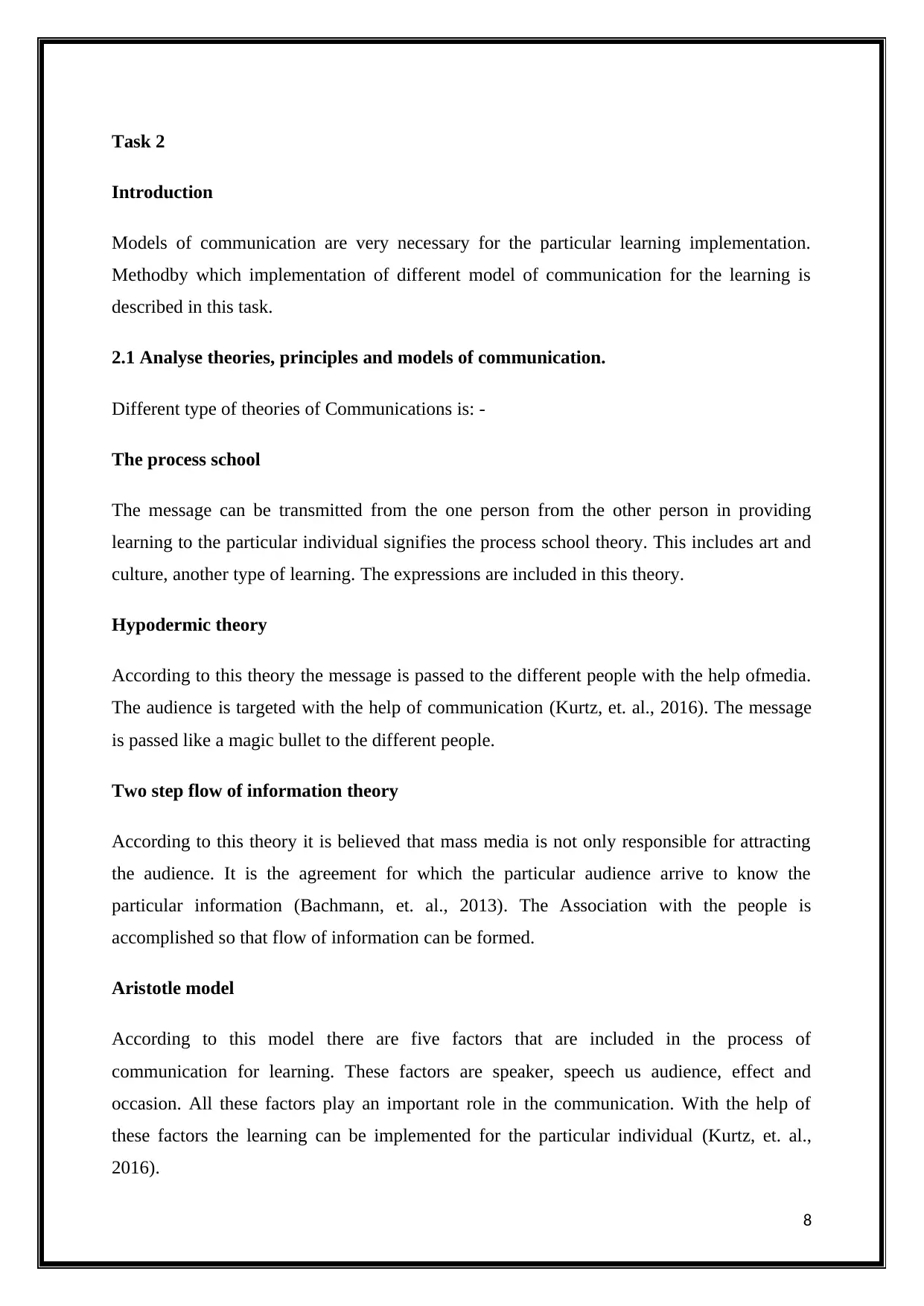
Task 2
Introduction
Models of communication are very necessary for the particular learning implementation.
Methodby which implementation of different model of communication for the learning is
described in this task.
2.1 Analyse theories, principles and models of communication.
Different type of theories of Communications is: -
The process school
The message can be transmitted from the one person from the other person in providing
learning to the particular individual signifies the process school theory. This includes art and
culture, another type of learning. The expressions are included in this theory.
Hypodermic theory
According to this theory the message is passed to the different people with the help ofmedia.
The audience is targeted with the help of communication (Kurtz, et. al., 2016). The message
is passed like a magic bullet to the different people.
Two step flow of information theory
According to this theory it is believed that mass media is not only responsible for attracting
the audience. It is the agreement for which the particular audience arrive to know the
particular information (Bachmann, et. al., 2013). The Association with the people is
accomplished so that flow of information can be formed.
Aristotle model
According to this model there are five factors that are included in the process of
communication for learning. These factors are speaker, speech us audience, effect and
occasion. All these factors play an important role in the communication. With the help of
these factors the learning can be implemented for the particular individual (Kurtz, et. al.,
2016).
8
Introduction
Models of communication are very necessary for the particular learning implementation.
Methodby which implementation of different model of communication for the learning is
described in this task.
2.1 Analyse theories, principles and models of communication.
Different type of theories of Communications is: -
The process school
The message can be transmitted from the one person from the other person in providing
learning to the particular individual signifies the process school theory. This includes art and
culture, another type of learning. The expressions are included in this theory.
Hypodermic theory
According to this theory the message is passed to the different people with the help ofmedia.
The audience is targeted with the help of communication (Kurtz, et. al., 2016). The message
is passed like a magic bullet to the different people.
Two step flow of information theory
According to this theory it is believed that mass media is not only responsible for attracting
the audience. It is the agreement for which the particular audience arrive to know the
particular information (Bachmann, et. al., 2013). The Association with the people is
accomplished so that flow of information can be formed.
Aristotle model
According to this model there are five factors that are included in the process of
communication for learning. These factors are speaker, speech us audience, effect and
occasion. All these factors play an important role in the communication. With the help of
these factors the learning can be implemented for the particular individual (Kurtz, et. al.,
2016).
8
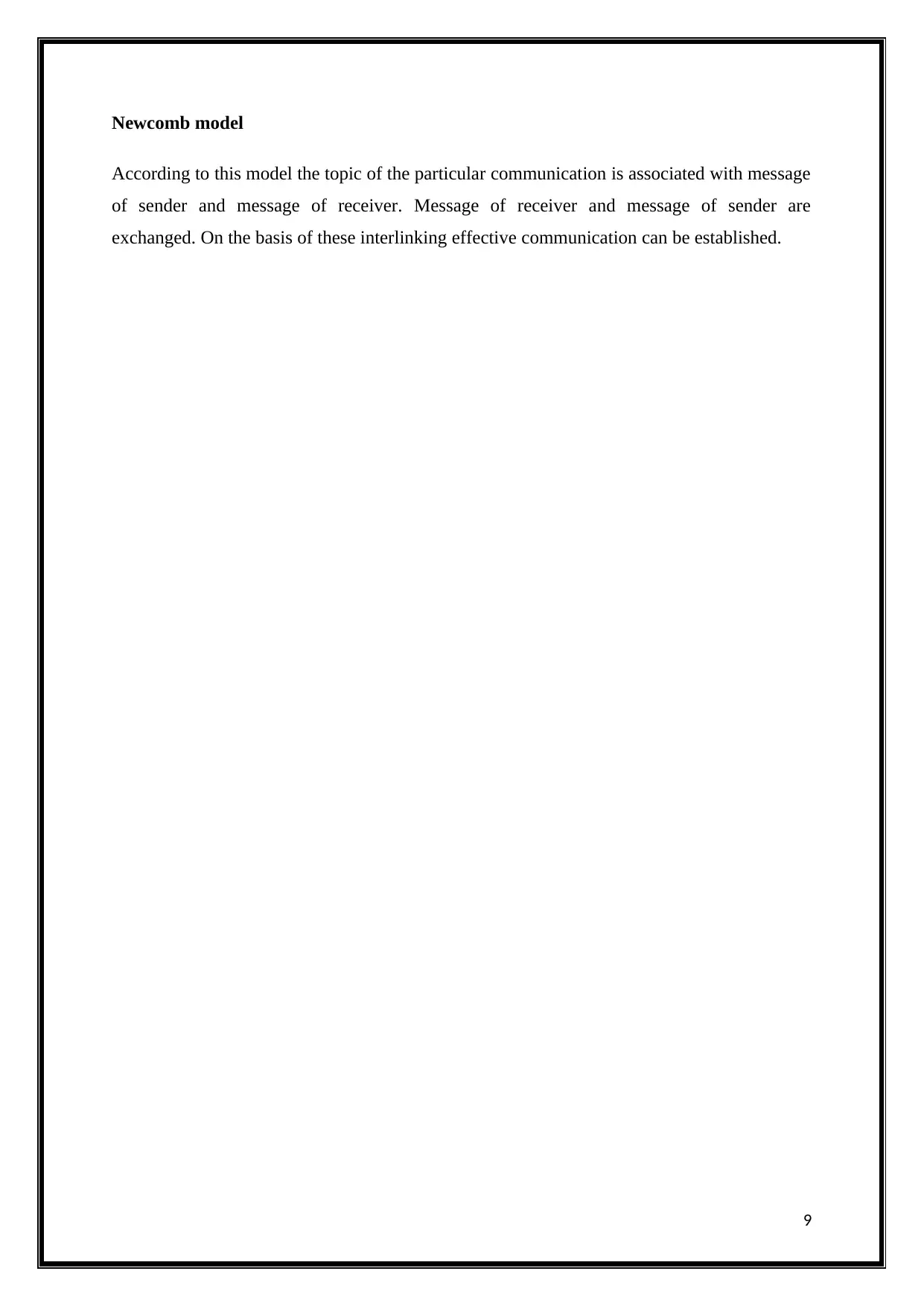
Newcomb model
According to this model the topic of the particular communication is associated with message
of sender and message of receiver. Message of receiver and message of sender are
exchanged. On the basis of these interlinking effective communication can be established.
9
According to this model the topic of the particular communication is associated with message
of sender and message of receiver. Message of receiver and message of sender are
exchanged. On the basis of these interlinking effective communication can be established.
9
⊘ This is a preview!⊘
Do you want full access?
Subscribe today to unlock all pages.

Trusted by 1+ million students worldwide
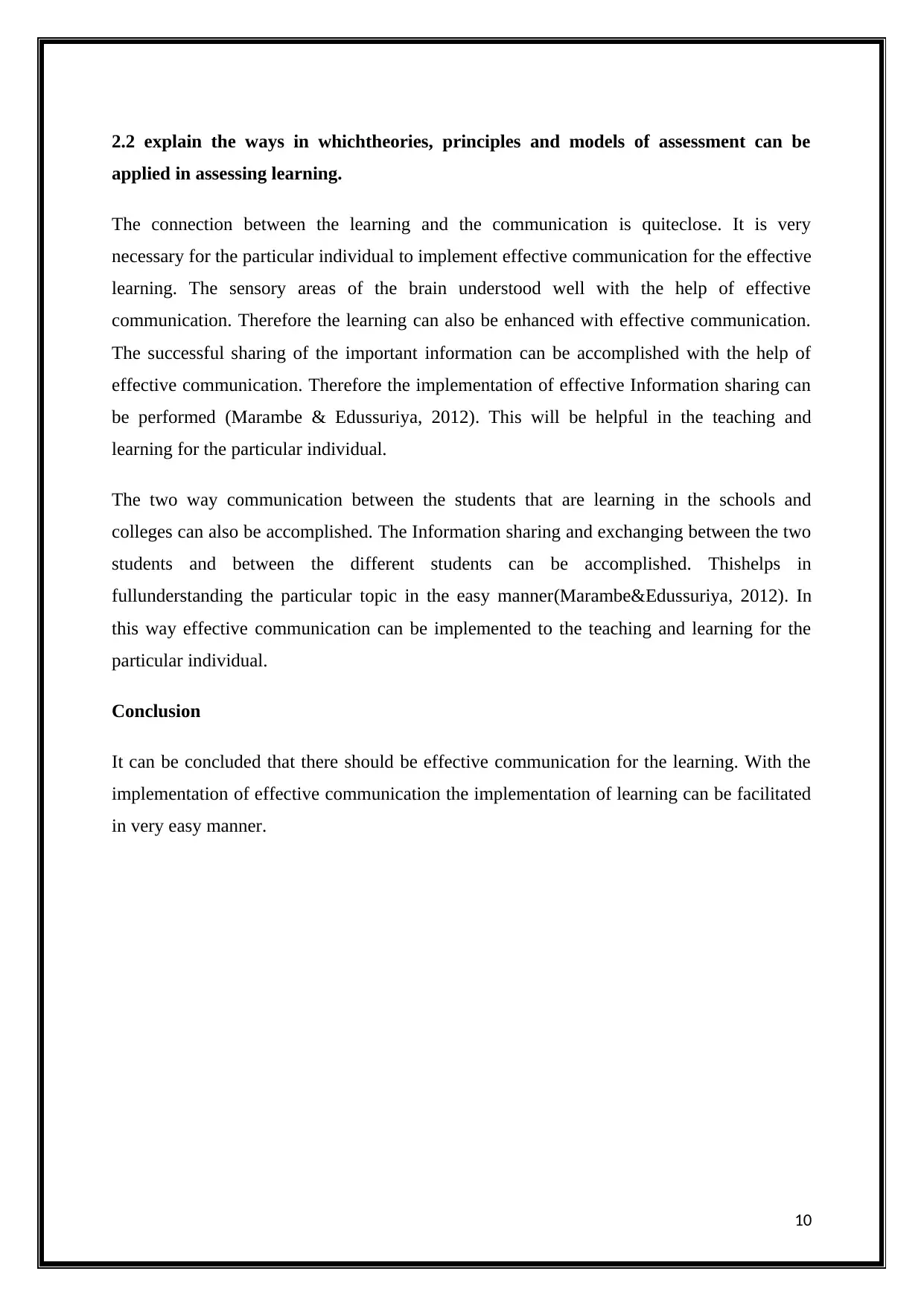
2.2 explain the ways in whichtheories, principles and models of assessment can be
applied in assessing learning.
The connection between the learning and the communication is quiteclose. It is very
necessary for the particular individual to implement effective communication for the effective
learning. The sensory areas of the brain understood well with the help of effective
communication. Therefore the learning can also be enhanced with effective communication.
The successful sharing of the important information can be accomplished with the help of
effective communication. Therefore the implementation of effective Information sharing can
be performed (Marambe & Edussuriya, 2012). This will be helpful in the teaching and
learning for the particular individual.
The two way communication between the students that are learning in the schools and
colleges can also be accomplished. The Information sharing and exchanging between the two
students and between the different students can be accomplished. Thishelps in
fullunderstanding the particular topic in the easy manner(Marambe&Edussuriya, 2012). In
this way effective communication can be implemented to the teaching and learning for the
particular individual.
Conclusion
It can be concluded that there should be effective communication for the learning. With the
implementation of effective communication the implementation of learning can be facilitated
in very easy manner.
10
applied in assessing learning.
The connection between the learning and the communication is quiteclose. It is very
necessary for the particular individual to implement effective communication for the effective
learning. The sensory areas of the brain understood well with the help of effective
communication. Therefore the learning can also be enhanced with effective communication.
The successful sharing of the important information can be accomplished with the help of
effective communication. Therefore the implementation of effective Information sharing can
be performed (Marambe & Edussuriya, 2012). This will be helpful in the teaching and
learning for the particular individual.
The two way communication between the students that are learning in the schools and
colleges can also be accomplished. The Information sharing and exchanging between the two
students and between the different students can be accomplished. Thishelps in
fullunderstanding the particular topic in the easy manner(Marambe&Edussuriya, 2012). In
this way effective communication can be implemented to the teaching and learning for the
particular individual.
Conclusion
It can be concluded that there should be effective communication for the learning. With the
implementation of effective communication the implementation of learning can be facilitated
in very easy manner.
10
Paraphrase This Document
Need a fresh take? Get an instant paraphrase of this document with our AI Paraphraser
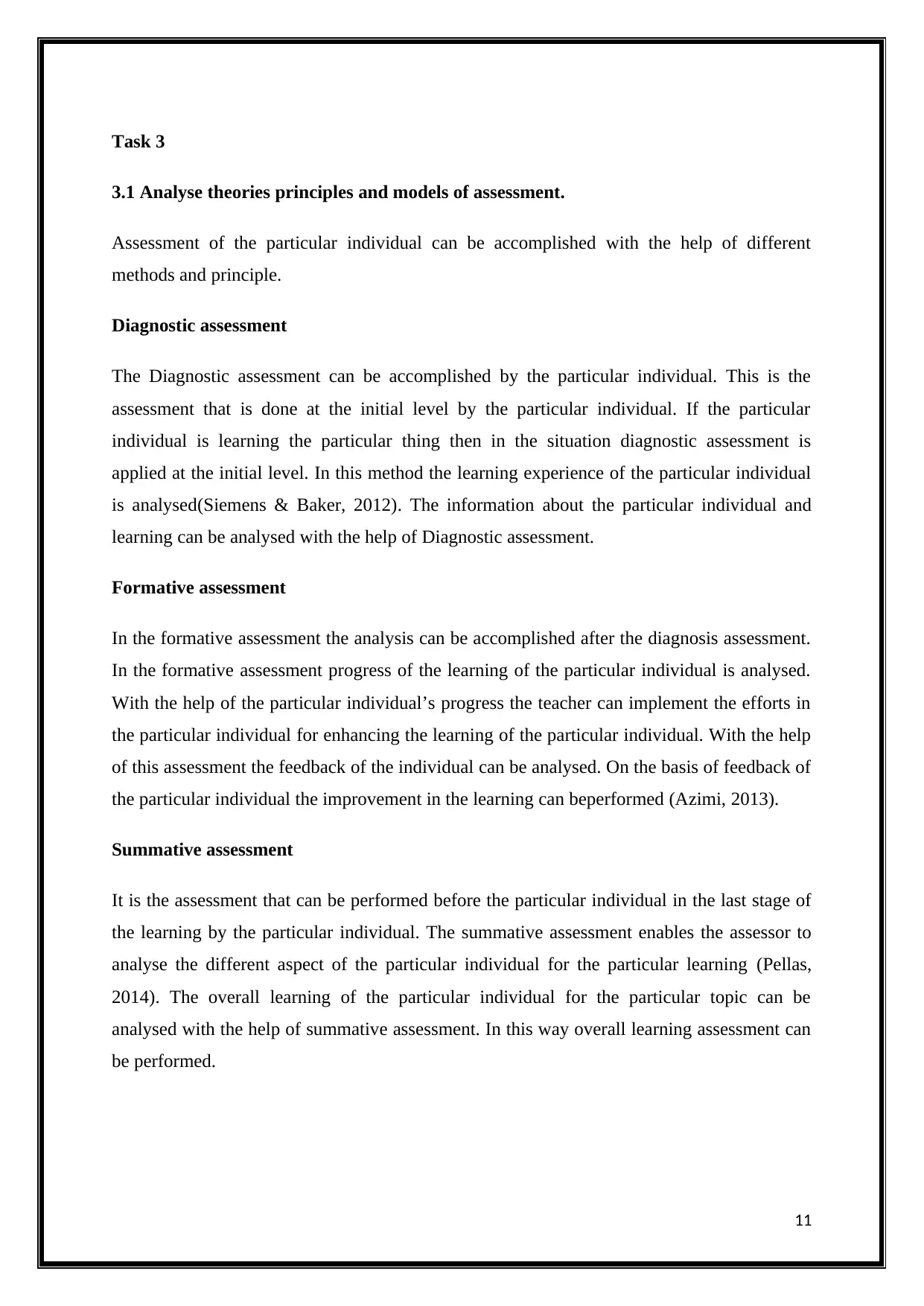
Task 3
3.1 Analyse theories principles and models of assessment.
Assessment of the particular individual can be accomplished with the help of different
methods and principle.
Diagnostic assessment
The Diagnostic assessment can be accomplished by the particular individual. This is the
assessment that is done at the initial level by the particular individual. If the particular
individual is learning the particular thing then in the situation diagnostic assessment is
applied at the initial level. In this method the learning experience of the particular individual
is analysed(Siemens & Baker, 2012). The information about the particular individual and
learning can be analysed with the help of Diagnostic assessment.
Formative assessment
In the formative assessment the analysis can be accomplished after the diagnosis assessment.
In the formative assessment progress of the learning of the particular individual is analysed.
With the help of the particular individual’s progress the teacher can implement the efforts in
the particular individual for enhancing the learning of the particular individual. With the help
of this assessment the feedback of the individual can be analysed. On the basis of feedback of
the particular individual the improvement in the learning can beperformed (Azimi, 2013).
Summative assessment
It is the assessment that can be performed before the particular individual in the last stage of
the learning by the particular individual. The summative assessment enables the assessor to
analyse the different aspect of the particular individual for the particular learning (Pellas,
2014). The overall learning of the particular individual for the particular topic can be
analysed with the help of summative assessment. In this way overall learning assessment can
be performed.
11
3.1 Analyse theories principles and models of assessment.
Assessment of the particular individual can be accomplished with the help of different
methods and principle.
Diagnostic assessment
The Diagnostic assessment can be accomplished by the particular individual. This is the
assessment that is done at the initial level by the particular individual. If the particular
individual is learning the particular thing then in the situation diagnostic assessment is
applied at the initial level. In this method the learning experience of the particular individual
is analysed(Siemens & Baker, 2012). The information about the particular individual and
learning can be analysed with the help of Diagnostic assessment.
Formative assessment
In the formative assessment the analysis can be accomplished after the diagnosis assessment.
In the formative assessment progress of the learning of the particular individual is analysed.
With the help of the particular individual’s progress the teacher can implement the efforts in
the particular individual for enhancing the learning of the particular individual. With the help
of this assessment the feedback of the individual can be analysed. On the basis of feedback of
the particular individual the improvement in the learning can beperformed (Azimi, 2013).
Summative assessment
It is the assessment that can be performed before the particular individual in the last stage of
the learning by the particular individual. The summative assessment enables the assessor to
analyse the different aspect of the particular individual for the particular learning (Pellas,
2014). The overall learning of the particular individual for the particular topic can be
analysed with the help of summative assessment. In this way overall learning assessment can
be performed.
11
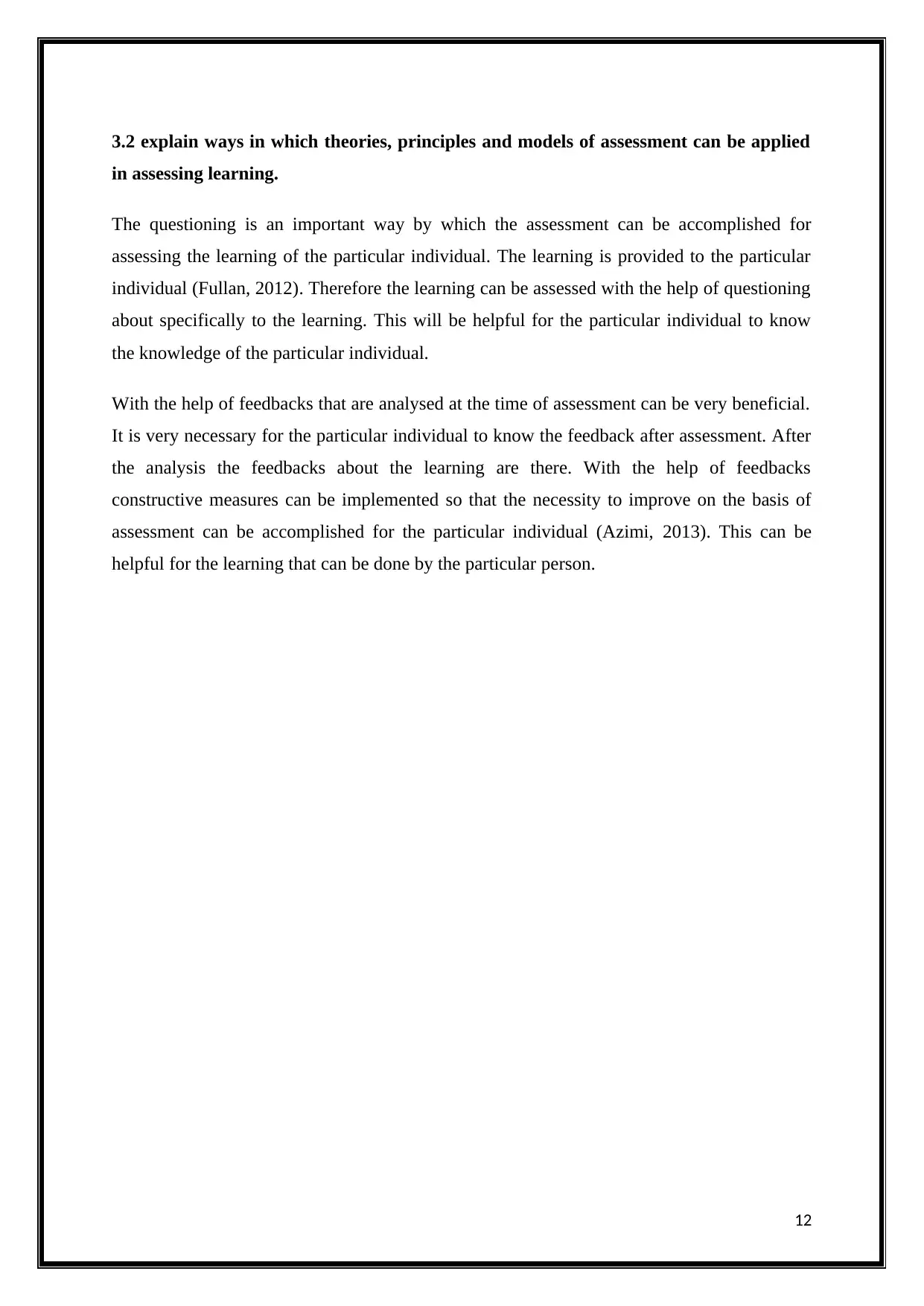
3.2 explain ways in which theories, principles and models of assessment can be applied
in assessing learning.
The questioning is an important way by which the assessment can be accomplished for
assessing the learning of the particular individual. The learning is provided to the particular
individual (Fullan, 2012). Therefore the learning can be assessed with the help of questioning
about specifically to the learning. This will be helpful for the particular individual to know
the knowledge of the particular individual.
With the help of feedbacks that are analysed at the time of assessment can be very beneficial.
It is very necessary for the particular individual to know the feedback after assessment. After
the analysis the feedbacks about the learning are there. With the help of feedbacks
constructive measures can be implemented so that the necessity to improve on the basis of
assessment can be accomplished for the particular individual (Azimi, 2013). This can be
helpful for the learning that can be done by the particular person.
12
in assessing learning.
The questioning is an important way by which the assessment can be accomplished for
assessing the learning of the particular individual. The learning is provided to the particular
individual (Fullan, 2012). Therefore the learning can be assessed with the help of questioning
about specifically to the learning. This will be helpful for the particular individual to know
the knowledge of the particular individual.
With the help of feedbacks that are analysed at the time of assessment can be very beneficial.
It is very necessary for the particular individual to know the feedback after assessment. After
the analysis the feedbacks about the learning are there. With the help of feedbacks
constructive measures can be implemented so that the necessity to improve on the basis of
assessment can be accomplished for the particular individual (Azimi, 2013). This can be
helpful for the learning that can be done by the particular person.
12
⊘ This is a preview!⊘
Do you want full access?
Subscribe today to unlock all pages.

Trusted by 1+ million students worldwide
1 out of 19
Related Documents
Your All-in-One AI-Powered Toolkit for Academic Success.
+13062052269
info@desklib.com
Available 24*7 on WhatsApp / Email
![[object Object]](/_next/static/media/star-bottom.7253800d.svg)
Unlock your academic potential
Copyright © 2020–2025 A2Z Services. All Rights Reserved. Developed and managed by ZUCOL.


